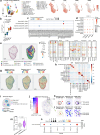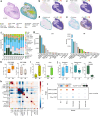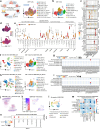Granzyme K+CD8+ T cells interact with fibroblasts to promote neutrophilic inflammation in nasal polyps
- PMID: 39614076
- PMCID: PMC11607458
- DOI: 10.1038/s41467-024-54685-1
Granzyme K+CD8+ T cells interact with fibroblasts to promote neutrophilic inflammation in nasal polyps
Abstract
Sophisticated interactions between stromal and immune cells play crucial roles in various biological and pathological processes. In chronic rhinosinusitis with nasal polyps (CRSwNP), the upper airway inflammation in many patients is driven by TH2, ILC2, and eosinophils, thus being treated with glucocorticoids and anti-type 2 inflammation biologics. The resistance to these therapies is often associated with neutrophilic inflammation, which has also been widely identified in CRSwNP, but the underlying mechanisms remain unclear. Using single-cell analysis, spatial transcriptomics, and T-cell receptor sequencing, we identify an increased presence of granzyme K+(GZMK+) CD8+ T cells in NPs, which possess a phenotype distinct from the cytotoxic GZMB+ effector CD8+ T subset. GZMK+CD8+ T cells are found to express CXCR4 and interact with CXCL12-secreting fibroblasts, inducing the latter to produce neutrophil chemoattractants in a manner uniquely mediated by GZMK but not other granzymes. This GZMK+CD8+ T cell-fibroblast crosstalk is also observed in other inflammatory diseases. Furthermore, GZMK+CD8+ T cells exhibit a selective expansion of clones that recognize Epstein-Barr virus. Here, we show that GZMK marks a phenotypically distinct subset of effector CD8+ T cells that promote neutrophilic inflammation.
© 2024. The Author(s).
Conflict of interest statement
Competing interests: The authors declare no competing interests.
Figures








References
-
- Fokkens, W. J. et al. European position paper on rhinosinusitis and nasal polyps 2020. Rhinology58, 1–464 (2020). - PubMed
-
- Bachert, C. et al. Endotypes of chronic rhinosinusitis with nasal polyps: Pathology and possible therapeutic implications. J. Allergy Clin. Immunol. Pract.8, 1514–1519 (2020). - PubMed
-
- Bachert, C. et al. Biologics for chronic rhinosinusitis with nasal polyps. J. Allergy Clin. Immunol.145, 725–739 (2020). - PubMed
-
- Han, J. K. et al. Mepolizumab for chronic rhinosinusitis with nasal polyps (SYNAPSE): A randomised, double-blind, placebo-controlled, phase 3 trial. Lancet Respir. Med.9, 1141–1153 (2021). - PubMed
Publication types
MeSH terms
Substances
Grants and funding
LinkOut - more resources
Full Text Sources
Research Materials

